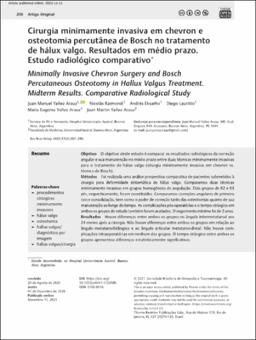| dc.contributor.author | Yañez, Juan Miguel. | |
| dc.contributor.author | Raimondi, Nicolás. | |
| dc.contributor.author | Eksarho, Andrés. | |
| dc.contributor.author | Et al. | |
| dc.date.accessioned | 2023-09-25T15:47:49Z | |
| dc.date.available | 2023-09-25T15:47:49Z | |
| dc.date.issued | 2021-11 | |
| dc.identifier.citation | Rev Bras Ortop (Sao Paulo) . 2021 Nov 11;57(2):250-256. | es |
| dc.identifier.issn | 0102-3616. | |
| dc.identifier.uri | https://riu.austral.edu.ar/handle/123456789/2302 | |
| dc.description | Disponible en: https://www.thieme-connect.com/products/ejournals/pdf/10.1055/s-0041-1729590.pdf | es |
| dc.description.abstract | Abstract
Objective The purpose of the present study is to compare the radiological results of angular correction and its maintenance in the medium term between two minimally invasive techniques for the treatment of hallux valgus (minimally invasive chevron surgery vs. Bosch technique). Methods A comparative prospective analysis of patients undergoing surgery for symptomatic hallux valgus deformity was performed. We compared two minimally invasive techniques in homogeneous groups of population. Two groups of 62 and 63 feet respectively, were constituted. We compared first ray angular corrections and consolidation as well as the correction power of both osteotomies and their maintenance over time. The postoperative complications and surgical time in both study groups were also evaluated. The minimum follow-up was 2 years. Results There were differences between both groups in the intermetatarsal angle at 24 months postsurgery. There were no differences between both groups regarding metatarsophalangeal angle, and distal metatarsal articular angle. There were no intraoperative complications in either group. The surgical time between both groups had statistically significant differences. Conclusions Both screw-stabilized, Bosch surgery and minimally invasive chevron (hybrid when associated with percutaneous Akin osteotomy) present adequate correction of moderate hallux valgus. However, patients treated with Bosch percutaneous surgery had a greater correction power of the intermetatarsal angle in the medium term, as well as a shorter surgical time, when compared with those who were treated with chevron osteotomy. Both techniques had a similar evolution over time regarding loss of correction and postoperative complications.
Keywords: hallux valgus; hallux valgus/diagnostic imaging; hallux valgus/surgery; minimally invasive surgical procedures; osteotomy.
Sociedade Brasileira de Ortopedia e Traumatologia. This is an open access article published by Thieme under the terms of the Creative Commons Attribution-NonDerivative-NonCommercial License, permitting copying and reproduction so long as the original work is given appropriate credit. Contents may not be used for commecial purposes, or adapted, remixed, transformed or built upon. ( https://creativecommons.org/licenses/by-nc-nd/4.0/ ). | es |
| dc.language.iso | en | es |
| dc.publisher | Thieme Gruppe | es |
| dc.rights | Attribution-NonCommercial-NoDerivatives 4.0 Internacional | * |
| dc.rights.uri | http://creativecommons.org/licenses/by-nc-nd/4.0/ | * |
| dc.subject | Hallux valgus. | es |
| dc.subject | Hallux valgus/diagnostic imaging. | es |
| dc.subject | Hallux valgus/surgery. | es |
| dc.title | Minimally Invasive Chevron Surgery and Bosch Percutaneous Osteotomy in Hallux Valgus Treatment. Midterm Results. Comparative Radiological Study | es |
| dc.type | Article | es |


